
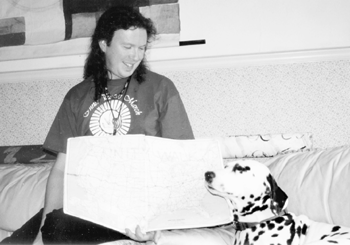 The Long Walk West
The Long Walk West From Ocean City, 7 step out
on faith. They'll
From Ocean City, 7 step out
on faith. They'll  walk 3,200
miles for Unity.
walk 3,200
miles for Unity.
 The Long Walk West
The Long Walk West
 From Ocean City, 7 step out
on faith. They'll
From Ocean City, 7 step out
on faith. They'll  walk 3,200
miles for Unity.
walk 3,200
miles for Unity.
 story &
photos by Mark Burns
story &
photos by Mark Burns
Paul Callens and pooch Sam, his 7-year-old Dalmatian, with their route across America.
It's not uncommon to succumb to the romantic appeal of nomadic exploration, taking leave of normal range to wander westward for a first-hand glimpse of what lies beyond the Appalachians.
But on foot?
Paul Callens, 37, of Annapolis, is that determined pedestrian. He and
six others who share in his grand vision - including three Annapolis locals,
one man from Mount Rainier in Montgomery County and a pair from Philadelphia
- form the core group of the Unity Walk, a not-quite-seven-month, 3,200-mile,
cross-country trek with the goal of establishing an annual Unity Day.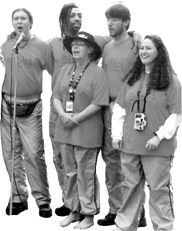
"It's sort of like an Earth Day for humanity," explains Callens, who envisions a day people celebrate in such small ways as extending common courtesies to strangers or in such big ways as festivals and concerts. Initially, Callens and the Unity Project - with the support of the Unity Now Coalition, a community group born of February, 1998's counter-rally against the Klan - are shooting for national recognition of the holiday; Callens hopes Unity Day will eventually thrive on an international scale.
But first they have to plant the seeds (literally: they're leaving a trail of black-eyed Susans from seeds they're handing out) and spread the good vibes to build support. Thus the Unity Walk, a lengthy stroll across America that started March 22 from the beaches of Ocean City and comes - organizers hope - to a climactic close October 10 in the shadow of San Francisco's Golden Gate Bridge.
 A Journey of 1,000 Miles
A Journey of 1,000 Miles
Only one day before the walkers were set to tromp across the Route 50 bridge to start the Unity Walk, the heavens opened and dumped a deluge on Ocean City. Not the best of weather for the beach party they had planned, stocked complete with amps and onlookers.
The walkers may very well be forced to endure this kind of weather along their trip. But not today - this is the big send-off party. So, the soiree is moved 90 blocks north to the indoor pool of the beachside Princess Royale hotel's oceanfront atrium. With over a dozen people there to celebrate, they plugged in the amps, waited politely for a kid's birthday party to finish up on the other side of the pool, then turned up their party. The band Organic played music and Callens delivered a Native American invocation.
Later that evening, around 9pm, the walkers plunged not once but twice into the Atlantic surf before retreating to the Royale's hot tubs and saunas. Looking ahead, Callens imagined that in October they'd "dive headlong into the water once we get to the Pacific." By braving the chilly, crashing surfs at either end, the Unity marchers will have earned the right to say they journeyed, quite literally, from "sea to shining sea."
By March 22, clouds had parted and sun shone brightly on the intrepid walkers, plus nearly 100 other people - many of them high school students. With two TV crews filming, they walked hand-in-hand to the surf, dipped hands, turned around and crossed North Division Street (a serendipitous twist of symbolism in Callens' eye) to start the Unity Walk in single file. The small army would log over six miles together, crossing the Route 50 bridge onto the mainland and beyond.
"To look back and see 100 people in a line following you is just stirring," remarks Callens. Before breaking off from the student body, they held a pow wow to reflect on the day. By sunset, the walkers had fallen short by almost half of their goal of 22 miles a day.
 What's Waiting Out West
What's Waiting Out West
The path they pound between the shores is US Route 50. They'll take the old road at points where the open highway morphs into interstate, on which it is illegal to walk. When possible, they'll use nearby footpaths; otherwise they'll stick to the shoulders. The route leads the walkers through or past Ocean City, Salisbury, Annapolis and Bowie in Maryland; Washington, D.C.; Arlington and Fairfax in Virginia; Clarksburg and Parkersburg in West Virginia; Cincinnati, Ohio; St. Louis, Jefferson City and Kansas City in Missouri; Emporia and Dodge City in Kansas; Pueblo and Grand Junction in Colorado; Delta, Utah; Carson City, Nevada; plus South Lake Tahoe, Sacramento and San Francisco in California - just to name a few towns in the dozen states they're traversing.
Natural obstacles are nearly as numerous. The seven-member core group must conquer three mountain ranges - the Appalachians, Rockies and Sierra Nevada. They must also span the wide-open spaces of the Great Plains and endure the socially stagnant stretch of 50 dubbed the 'Loneliest Highway on Earth,' which starts in western Utah and cuts a path through the Painted Desert in Nevada. At some points, they'll even have to paddle. In Maryland, where Route 50 crosses the Chesapeake at the Bay Bridge, state officials have deemed it too unsafe to walk across. The solution? Callens and fellow walker Ajax Joe Drayton will cross via canoe in the company of a small flotilla boasting three independent vessels and theMaritime Republic of Eastport's navy.
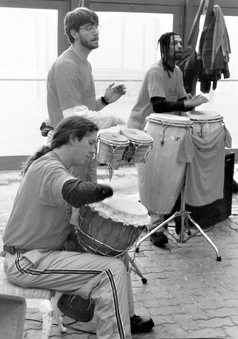
As if geographical obstacles weren't enough, the Unity Walkers aren't
afforded the luxury to pause for nasty weather to pass - "We'll trudge
on through," declares Callens. To finish at San Francisco by October
10, they must cover 22 miles a day, five days a week over 203 days, relying
on strangers' charity as much as a small stockpile of socks and shoes.
"There's a conscious element of drama designed into it," admits
Callens, a trained thespian. "To some extent, I see this as some sort
of huge performance art piece." By walking the peaks and valleys and
deserts and plains and forests of the United States on foot and braving
whatever the heavens might hurl down upon them, the walkers hope to declare
the depth and sincerity of their resolve.
"The Unity Walk will not be denied," touts an enthused Callens.
Unity walkers Callens, Ben Thompson and Ajax Joe Drayton, left, drum up their spirits at a kickoff party the day before beginning their 3,200-mile hike.
 Digging in for the Long Haul
Digging in for the Long Haul
Just how many pairs of shoes does a guy need for walking 3,200 miles?
"In theory, four pairs in rotation would do it," says Callens. That's two pairs for fair weather and two for foul. With footwear rotated every half-day, shoes have a chance to dry out so they won't rot. Even so, soles will take a beating, and its up to benefactors to refresh the stockpile. "As of two weeks ago I was walking around in shoes that had holes in them," saysCallens, who now sports a fresh pair.
When not walking, the core group and any tag-alongs are eventually going
to be transited by a retired 1979 International Harvester school bus donated
by Annapolis musician Blake Cramer, who bought it long ago at auction and
let it sit unused on his farm. Under the care of the Unity Walkers, it's
in the process of getting a makeover and overhaul - including mechanical
fixes, storage shelves for all the walkers' earthly possessions, a white
paint job with a purple stripe down the side and window curtains decorated
with a flurry of multicolored handprints in the 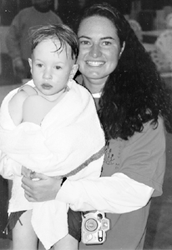 shapes
of doves carrying olive branches. And don't forget the water closet for
those roadside emergencies. "It's being fitted with a self-composting
marine toilet and a carpenter has volunteered to build an enclosure for
it," says Ben Thompson, a walker and driver.
shapes
of doves carrying olive branches. And don't forget the water closet for
those roadside emergencies. "It's being fitted with a self-composting
marine toilet and a carpenter has volunteered to build an enclosure for
it," says Ben Thompson, a walker and driver.
Kristie Wisniewski and her 3-year-old son, Jude, the youngest walker.
The Unity Bus should be ready in time for the Washington, D.C., celebration. Until then, the entourage motors about like sardines in a small convoy of a tightly packed Jeep Wrangler and Cherokee. There's also the matter of licensing. Sometime during their Maryland road trip, Ben Thompson, Kristie Wisniewski and Judy Rogers - all walkers who will split time behind the Unity Bus' wheel - must earn their commercial driver's licenses to be legal. They're searching for a retired bus driver who might like to donate expertise and seven months' time on the open road.
Lodging is whatever shelter they can get. "Whenever possible we'll stay in homes," says Callens, "which gives us the opportunity for showers and doing laundry." When not partaking of the hospitality of benefactors the walkers will camp in tents and a teepee - or, when it's really nasty out, in the bus, the cornerstone of the caravan. They've also recruited the support of YWCA centers, Bahá'í Faith groups and community colleges lining the route - the latter thanks to Anne Arundel Community College's sponsorship.
Days last from 8am to 5pm. Before walkers get into their stride by 8:30am, they warm up with stretches and meditation. Transport leapfrogs five miles ahead during the walk to serve as a mobile rest stop. At lunch, the walkers take an hour and a half off and guide those who've joined in giving each other foot massages. After treating tired tootsies, they go back on course to finish the day's travels and ride the bus from the stopping point to wherever they're resting that night.
Each week includes five days of walking, the days of rest being Thursday and Sunday. Thursdays are lazy in comparison to Sundays, which feature community celebrations in host towns and cities. Venues are chosen from towns along the week's route; at the end of each week, the walkers are loaded up and shipped to whichever town that happens to be. These days are planned for festivals of camaraderie, tapping local talent for concerts and volunteers for creating, then training with, Big Sticks. Drayton's invention, a Stick is made from a 12-foot cardboard carpet roll tube and painted as a kind of uprooted totem pole of personal power to be hurled and twirled around rhythmically in an exercise of creative movement.
Still, most exercise is in the strides. Which brings to mind a question: What does a person do to buff up for hiking along 3,200 miles of paved pathways?
Walk.
"Since September I've been walking everywhere," said Callens
in a pre-walk interview. Each day he hiked four to 12 miles in his hometown
of Annapolis to condition himself. He also got a boost from Eddie Stewart,
the artistic director for the Ballet Theatre of Annapolis, who gave him
free ballet lessons - the vigorous dance exercises were excellent for getting
in shape - in exchange for playing the role of Clara's father in last December's
Nutcracker production. Nearer the dawning of the walk, the entire core group
trained on long walks and got psyched up with pep talk pros, including a
free session from a corporate team-building expert.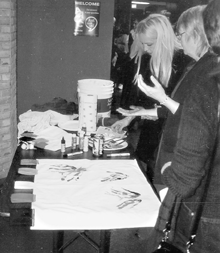
Supporters at the Step-One Unity Party at AACC use their hands to create doves on the curtains that will hang in the Unity Bus.
 The Roots of Unity
The Roots of Unity
"We're shooting for national recognition, but ultimately we hope for it to be an international holiday," says Callens. Unity Day's date - October 10 - is no accident; it's scheduled to be the day before Columbus Day. The aspiring holiday has been positioned to provoke thought about and act as a balance against uncomplimentary historic truths of imperialism, oppression and heavy-handed intolerance that he sees Columbus Day to embody. More importantly, it's a positive focus for building better communities.
Twelve years ago, a snap of enlightenment from a near-death experience delivered Callens the vision to cross the United States on foot to promote harmony among humanity. It wasn't until a rap session in December of '97 that he revealed it to the public. "In the last few years, I began sensing the time was right," says Callens, though he was hesitant to make mention of his grand machinations for fear of being "perceived as a kook."
But he wasn't. In fact, Ellen Moyer - an Annapolis alderwoman sitting beside him for the session and whose judgment he at first feared - was the first to praise his plan. Now she chairs the Unity Project's board of directors. "This is just the beginning of a much longer dialogue," says Moyer, who describes the walk as a catalyst to get communities to confront their problems and focus their efforts on solving them.
Moyer is not alone in trumpeting the cause. In Annapolis, the epicenter of the campaign, those ideals may be taking root. "It's really heartwarming to see how many people have been moved by this vision," says Callens. His inspired mission gained a stronger sense of purpose - and a name to boot - after the lopsidedly victorious counter-rally against the Ku Klux Klan on February 7 of 1998.
Callens is the first to admit that it's hard to blend abstract vision and bureaucratic process. As a non-profit group, the Unity Project can't lobby its cause to legislators, and that can get sticky. But they can and will take it to the people.
The Unity Walkers hope to have an effect similar to Forrest Gump's fictional criss-crossing of the country, drawing inspired followers into their wake along legs of the trip. The first, from Ocean City to D.C., has already drawn four people, with more expected to hook up as the walk cuts through Annapolis.
Where to Catch up For the first few days, Unity walkers wander the homefront, making stops at Harriet Tubman's birthplace, the Wye Mills Conference Center (where strides were made in peace negotiations between Israelis and Palestinians last year), Annapolis and Washington, D.C. Annapolis celebrates their arrival on March 30, as the walkers make tracks from Anne Arundel Community College down the B&A Trail, across the Naval Academy Bridge and to the Liberty Tree at St. John's college for a ceremony from noon to 1pm. From there they stop by the Thurgood Marshall statue before taking West Street out to Rt. 450, calling it quits for the day once they reach South River. Next up is Washington, D.C., site for the Great Reconnect. The march - a counter-rally against the Great Disconnect - starts 8:30am on April 3 from 34th Street and Rhode Island Avenue in Mount Rainier. Walkers follow Rhode Island into the city, turn left on North Capitol Street and stop on the Supreme Court steps at 11:30am. From there, they foot the short distance over to the west steps of the Capitol by 12:30pm. They then descend the steps to the patch of the National Mall closest to the Capitol for a 29-hour vigil, running non-stop from 1pm on April 3 to 6pm on April 4 with an expected 1,000 people. On their way out of town on April 5, they make a stop at the White House at 10am, completing the Great Reconnect before continuing along their westward course. In D.C., catch up with walkers around 9:30am when they pass near the Rhode Island Avenue Metro station or at 11am near the Union Station Metro. -MB |
 Fellowship of the Footsore
Fellowship of the Footsore
Unity walkers Kristie Wisniewski, Thompson,
Callens and Drayton, along with the Unity Project's volunteer executive
director and fellow-walker Barbara Hale seated in background. Callens holds
his 'Big Stick,' which he crafted as a personal totem and uses as a giant
baton.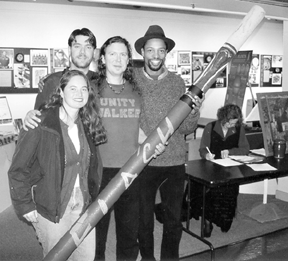
Some may think it daft to walk across the country in pursuit of this
lofty cause. Still others might believe it improbable to pull off such a
daunting endeavor. Especially in the face of having to sacrifice jobs, apartments,
cars and lifestyles to do it.
Actually it's more of a passion for the cause of peace and harmony among humanity rather than some funky mania that drives these people. Their enthusiasm is fueled by the countless others who have gone before; some of whom even doled out advice to them. Among the predecessors who've offered guidance is Sam Shepherd Jr. - the son of the Chicago man wrongly accused of murder in the real-life ordeal that inspired first the television series, then a movie titled The Fugitive. Shepherd walked from Chicago to New Orleans to promote justice. Unity Walkers have built their can-do attitude in meetings with Shepherd and other veteran voyagers.
"For the most part it's an act of faith," says Callens, who remains eager in the face of challenges. He's the tall, long-haired, easy-going group leader. Before the walk, he worked at Maryland Hall, teaching preschoolers drama, art and music. Now he's busy working out bugs on the fly. Among the concerns to overcome? In the beginning, the walk had barely enough funds to get started. There are the stresses of unforeseen complications along the route, having good shoes to walk in and maintaining a strong base of community support.
But these walkers exude an air of faithful confidence that it'll all come together nicely. "The obstacles just seem to fall away," says Drayton, 37, the only walker other than Callens planning to walk every step of the 3,200-mile pilgrimage.
Drayton - a tall, trim, muscular dancer with dreadlocks flopped over to one side of his head and the owner of the Ajax Moving Company dance studio - is the most outwardly enthusiastic walker of the bunch. He's been itching to get going. "It's like you're a surfer," he relates. "You feel the tsunami coming and you're planning to ride it all the way to the other coast."
He was the first to catch Callens' wave. The two first met in the theater program at Montgomery County Community College; 15 years later, they met up again and Callens invited Drayton along for the walk. "He had me in the first few minutes," says Drayton.
Kristie Wisniewski, a 24-year-old phys-ed teacher at an inner-city elementary school in Philadelphia, discovered the walk in the artists' tent at the Tibetan Freedom Concert. "I followed up over the Internet, resigned from my job and came down here." She's bringing her three-year-old son Jude along, towing him in a wagon for the pedestrian portions when she's not driving the Unity Bus.
Judy Rogers, 57, is a grandmother of two who's already visited 44 states. Not a nine-to-five type, she's been a cook on a private yacht and has waitressed on and off for 39 years. A friend of Callens, she got the second invitation to join on the night of the 1997 rap session. "He kind of looked at me and said 'Would you want to?' and I said 'YES.'" Her only concern is driving the bus in the mountains. "Going up the mountain isn't the problem; I just hope the brakes hold out on the way down."
Barbara Hale is the point-person of the group and the Unity Project's volunteer executive director. Retired from her post as director of Anne Arundel's YWCA, she now focuses her talents on coordinating the walk with local law enforcement agencies, pulling together fund-raisers, soliciting donations, making community contacts, getting the word out and keeping things organized when locals join in for segments of the walk. She's walking, too. Hale chose last-minute to forgo staying settled as the omniscient overseer from her home office, deciding she'd serve better on the road. Now, when not forging ahead to blaze the trail, she hooks up with the group on Wednesdays to log some walking time.
Ben Thompson, 24, plans to drive, walk and help Hale forge ahead when putting together the big celebrations - such as in St. Louis and Kansas City. Though not as thoroughly trained as Callens and Drayton, he's certain he won't lag. "I've been keeping pace with Paul and Ajax pretty well," says Thompson, who expects to do just fine on the long walk - "just as long as the blisters don't get too bad." Up until the walk, he'd waited on tables at the Treaty of Paris restaurant for several years. He hopes to use this walk's experience to build a career as a social studies teacher.
A few walkers carry symbolic charms or objects from friends and loved ones as tributes. Callens wears a multicolored bead necklace fashioned by his sister (to represent all races as one) and a Native American necklace given to him by his grandmother. Thompson wears a brass pendant with the African continent punched out in the center, an artifact from and in honor of the late Annapolis musician Artie Dix. Rogers will wrap around her waist a music-themed tie from Mickey Basil.
Everyone is looking forward to something in particular they're on the trip. Callens is most anxious to see Lake Tahoe. Drayton might like to see some tumbleweed tumbling. Thompson wants the challenge of the desert. Rogers can't wait to hit the Scott Joplin ragtime festival near Dodge City. Overall, everybody's eager to see a little bit of everything along the tour. But at least one wouldn't mind happening upon a fire hydrant or two.
Though technically not a core walker, Callens' seven-year-old Dalmatian, Sam, is coming along as well. "I guess it was fateful that he's a Dalmatian, blending black and white," says Callens, who thinks Sam a fitting mascot for the walk's theme of inter-ethnic harmony. But, he allows, "once this is over he may be hesitant to ask to go for a walk."
 What Next?
What Next?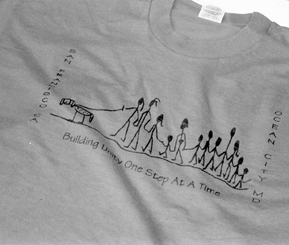
The Unity Walkers aren't certain what they'll do when they run out of firm footing at the Pacific surf. They will kick up heels at the climactic Unity Day concert party on October 10 at Golden Gate Park. Then, who knows? Somebody has to return Cramer's bus. And they'll continue to champion the cause - Callens' goal is to win national recognition within the first couple years of the second millennium.
None of the core walkers can say for sure what they'll be doing beyond that, though. Wisniewski might visit a few friends out in California; others also hint that they might hang around out west a while before heading home. But Callens suspects he might not want to stop.
"Maybe I'll keep heading west until I come back from the other side ."
Want to help or join? Donations are gratefully accepted throughout
the trip. Log on at www.unityday.org
or zap e-mail to [email protected]
for more information, including daily journal entries from the core walkers
and the Unity Walk's complete wish list. Orange Unity Walk T-shirts are
also for sale to raise funds for $18 apiece.
Paul on Day One: March 22, 1999 While walking along Route 50 on the Eastern Shore with Ajax Joe Drayton, Paul reflected over a cell phone with NBT on how things have gone so far in preparing for and beginning the walk. This is what he had to say: "The first gathering, in fact the whole week getting to today has been a microcosm of the metaphor that the Unity Walk is. "What it is is a metaphor for dealing with the issues that divide us in moving towards unity. In the process of doing that, you run into obstacles, some of which seem insurmountable. Issues like finding out at the last minute that you've been operating under erroneous advice that you don't need a commercial driver's license when in fact the law has changed and we can't even get our bus out of the garage and tagged unless we have a commercial driver's license which takes six weeks to get. And knowing that, in fact, if you step back and think it through, you can get around it. "The walkers were training last week and training together for the first time. We discovered that we are all really very different. Things like the rain pouring down on the first day. These are the kinds of things anybody pursuing unity will have to endure. We've faced all these things last week. Yet we haven't abandoned the goal, we've stayed at the table even when solutions didn't present themselves. We've continued to press forward no matter what is trying to stop us. "As the Unity Walk is a metaphor, this week has been a success. And we're so thankful for all the energies coming to supporting this project." -MB |
| Issue 12 |
Volume VII Number 12
March 25-31, 1999
New Bay Times
| Homepage |
| Back to Archives |